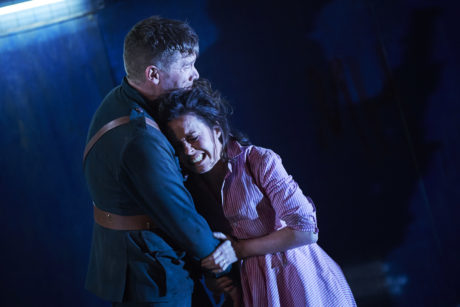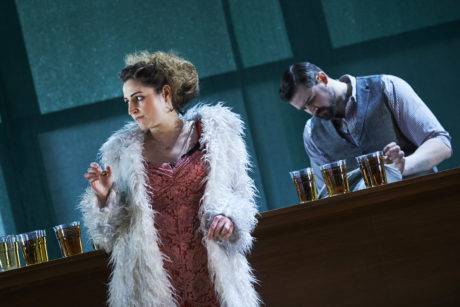An adventurous new take on Sean O’Casey’s The Plough and the Stars brings a fragile yet startling version of the Irish classic to the Annenberg Center stage courtesy of the Abbey Theatre in Dublin. Coming to the end of its North-American tour this production is definitely one for a new generation, while marking the 100th anniversary of the Easter Rising.

Under the direction of Sean Holmes, the staging deconstructs the familiar play, penetrating to the grim, grimy core of a Dublin tenement and the heroic or not-so-heroic sacrifices made in the face of rebellion and war. Time becomes fluid and realism disappears as the characters inhabit the world of the 1916 Ireland just as much as the present theater space itself. For every moment captured in the day-to-day tragedy of starvation and turmoil, there is an equally presentational take to the audience, framing each character as equal parts narrator and victim.
O’Casey’s subversive take on this historic moment in Irish history has a rich background. Its 1926 premiere, just ten short years after the actual Easter Rising, was greeted with rioting. This new anachronistic interpretation doubles down on the story’s universality while venturing widely outside the comfort zone of a beloved standard.
The stellar cast deserves their fair share of praise, uniformly impressive in their purpose. Jack Clitheroe (Ian-Lloyd Anderson) and his wife Nora (Kate Stanley Brennan) resonate beautifully in the tragedy of the conflict throughout. Bringing both comic relief and gravitas is a chorus of pros as Fluther (David Ganly), Peter Flynn (James Hayes), Mrs. Gogan (Janet Moran), and Bessie Burgess (Eileen Walsh), along with the haunting presence of Mollser (Rachel Gleeson) and fiery magnetism of The Young Covey (Ciaran O’Brien) filling out the neighborhood.

Updating this version of Dublin, Set Designer Jon Bausor embraces the poor minimalism of the slums with graffiti and bare-bones industrial ornamentation, while almost literally turning the world upside down as the violence escalates. Paul Keogan’s lighting design surrounds the stage with harsh fluorescent lights and the gritty danger of the tenement. Costume Designer Catherine Fay brings familiar jeans and sweaters into the contemporary mix, balancing the military and civilian dualism of the cast.
Music and Sound Designer Philip Stewart deftly identifies music as a crucial part of Ireland’s beating heart in this world, tracing melodies throughout that range from the careful whistling accompaniment of a silent scene to the boisterous crooning love song filled with tenuous joy; not to mention the thumping rambunctiousness in the scene changes.
It’s difficult not to bring the word “Brechtian” into any conversation of Holmes’ concept at work. O’Casey’s comedy shines through brilliantly in the sooty world he creates, carrying eerie lightness throughout to temper the innate tragedy. But while mining the depths of those emotional ranges, he still extracts large portions of the momentum to communicate with the audience, both in direct sustained eye contact from various actors and in loud cabaret-like musical interludes. And while the insights of the original script resonate as they always have, there is an alienation at work that diffuses even the most powerful scenes, both to the production’s benefit and detriment.

It is tenuous line to tread when introducing such an impactful new world onto an existing play, though not an uncommon one. The most obvious parallel can be drawn to Ivo van Hove’s recent production of The Crucible reimagined out of Puritan Salem and into a contemporary classroom construct which fed familiarly on intense paranoia. But as Holmes both relocates and subverts this 1916 Dublin, he may abstract his purpose by one degree too many.
What’s left at the end is pure devastation and a revisiting of the ghosts of those lost to the uprising, voices of history longing for their stories to be told. An intense self-consciousness defines this version of The Plough and the Stars, carried on the sturdy frame of a superb ensemble and a universal tale of sacrifice. While this may not be the easiest entry point for the new viewer, the powerful impact of this deconstructed retelling is undeniable.
Running Time: Two hours and 40 minutes, with one intermission.
The Plough and the Stars plays through October 16, 2016, at Annenberg Center’s Zellerbach Theatre – 3680 Walnut Street, in Philadelphia, PA. For tickets call (215) 898-3900, or purchase them online.




